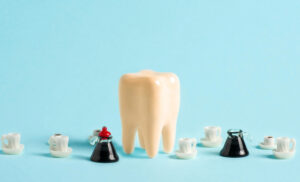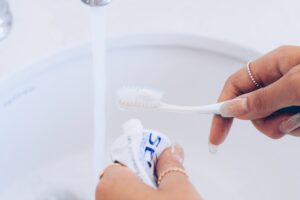Tooth enamel is one of the most important parts of your teeth. It acts as a hard, protective layer that shields your teeth from damage caused by chewing, biting, and exposure to acids from food and drink. However, enamel is not indestructible. Over time, it can wear down, leaving your teeth vulnerable to cavities, sensitivity, and other problems. One question that often comes up is: Can toothpaste repair enamel?
This article will explore whether enamel can be repaired, how toothpaste plays a role in enamel health, and what steps you can take to protect your teeth for a strong, healthy smile.
What is Tooth Enamel?
Tooth enamel is the hard, outer layer of your teeth. It’s actually the hardest substance in the human body, even stronger than bone. Enamel covers the crown of each tooth and helps protect the inner layers, like the dentin and pulp, from damage. It also guards against the effects of acids and bacteria that can lead to tooth decay.

Despite its strength, enamel can’t regenerate once it’s lost or worn away because it doesn’t have living cells. This is why protecting your enamel is so important—once it’s gone, it’s gone for good.
Functions of Tooth Enamel:
- Protects inner layers of the teeth from damage and decay.
- Shields teeth from acids in food and drinks.
- Prevents tooth sensitivity by covering sensitive parts of the teeth.
Can Tooth Enamel Be Restored with Toothpaste?
Unfortunately, once enamel is lost, it cannot be fully restored. Since enamel doesn’t have the ability to grow back, it can’t regenerate like other parts of the body, such as skin or bone. However, some toothpastes are specially designed to help strengthen and protect the enamel that remains, preventing further damage.
These toothpastes often contain ingredients like fluoride or calcium, which can help reinforce the enamel, making it more resistant to acids and decay. While these toothpastes can’t replace lost enamel, they can help remineralize weakened areas, making your teeth stronger and less prone to damage.
What Toothpaste Can Do for Enamel:
- Strengthen weakened enamel through remineralization.
- Protect against further damage from acids and bacteria.
- Prevent cavities by reinforcing the tooth’s outer layer.
Is There a Toothpaste that Specifically Repairs Enamel?

Yes, there are toothpastes on the market that are specifically formulated to protect and strengthen enamel. These toothpastes are often labeled as “enamel repair” or “enamel strengthening” and contain active ingredients that support enamel health. Some common ingredients found in these toothpastes include:
- Fluoride: The most common ingredient in toothpaste, fluoride is known for its ability to remineralize teeth and prevent cavities. It helps strengthen enamel by attracting minerals like calcium and phosphate to the tooth’s surface.
- Hydroxyapatite: A naturally occurring mineral in teeth, some toothpaste contains synthetic hydroxyapatite, which mimics the mineral that makes up tooth enamel. It can help repair micro-damage to the enamel.
- Calcium and Phosphate: These minerals are essential for building strong enamel. Some toothpastes contain ingredients that deliver calcium and phosphate directly to the enamel, helping to strengthen it.
These toothpastes won’t reverse severe enamel damage or replace lost enamel, but they can help reinforce areas of weakened enamel, making it more resistant to future wear.
Examples of Enamel-Strengthening Toothpastes:
- Sensodyne Pronamel – Designed to help protect against acid erosion and strengthen enamel.
- Colgate Enamel Health – Contains fluoride and other ingredients to remineralize and strengthen enamel.
- Regenerate Enamel Science – Uses patented ingredients to help repair early signs of enamel erosion.
Can You Reverse Enamel Damage?
While toothpaste can help strengthen weakened enamel, it cannot reverse severe enamel damage or bring back enamel that has already been lost. This means that once enamel has worn away due to erosion or decay, it won’t grow back. However, toothpaste can help slow down or stop further damage by reinforcing the remaining enamel and preventing more of it from wearing away.

Early stages of enamel erosion, when the damage is minor, can sometimes be repaired with the right toothpaste and dental care. The minerals in enamel-strengthening toothpaste can help remineralize the surface of the teeth, making them stronger and more resistant to future damage.
How to Prevent Further Enamel Damage:
- Use fluoride toothpaste to strengthen and protect your enamel.
- Limit acidic foods and drinks, like soda and citrus, which can weaken enamel.
- Avoid brushing too hard, which can wear down enamel.
- See your dentist regularly for checkups and cleanings.
What Causes Enamel Erosion?
Enamel erosion happens when acids attack and wear away the surface of your teeth. This can happen over time due to factors like diet, dental habits, and medical conditions. Some common causes of enamel erosion include:
- Acidic Foods and Drinks: Foods like citrus fruits, tomatoes, and soda are high in acids that can weaken enamel. Frequent exposure to these acids can wear down the enamel, especially if you don’t brush your teeth afterward.
- Sugary Foods and Drinks: Bacteria in your mouth feed on sugar and produce acids that attack tooth enamel. This is one of the main reasons sugary snacks and drinks are bad for your teeth.
- Brushing Too Hard: While brushing is important for good oral hygiene, brushing too hard or using a toothbrush with stiff bristles can wear away enamel over time. It’s best to use a soft-bristled brush and gentle, circular motions.
- Teeth Grinding (Bruxism): Grinding your teeth, especially at night, can put pressure on the enamel and cause it to wear down. If you grind your teeth, your dentist may recommend wearing a mouthguard at night to protect them.
- Dry Mouth (Xerostomia): Saliva helps wash away acids and bacteria from your teeth. If you have dry mouth, you may be at a higher risk for enamel erosion because there’s less saliva to protect your teeth.
Ways to Avoid Enamel Erosion:
- Drink plenty of water to keep your mouth hydrated.
- Rinse your mouth with water after consuming acidic foods or drinks.
- Use a soft-bristled toothbrush and avoid brushing too soon after eating acidic foods.
- Limit sugary snacks and drinks, and opt for tooth-friendly options like cheese and vegetables.
Can Tooth Enamel Be Rebuilt?
While it’s impossible to rebuild enamel that has been completely worn away, you can remineralize weakened areas of your enamel with proper dental care. Remineralization occurs when the minerals that make up enamel—calcium, phosphate, and fluoride—are redeposited onto the tooth’s surface. This helps to strengthen the enamel and prevent further damage.

Fluoride toothpaste is especially effective in this process because it helps attract minerals back to the tooth’s surface. In addition to using fluoride toothpaste, making smart dietary choices can help promote remineralization. For example, eating foods rich in calcium, like dairy products and leafy greens, can provide the minerals your enamel needs to stay strong.
What Happens if Enamel Erosion is Left Untreated?
If enamel erosion is left untreated, it can lead to several serious dental problems. Since enamel protects the sensitive inner layers of your teeth, erosion can make your teeth more vulnerable to cavities, sensitivity, and even tooth loss. Some of the most common consequences of untreated enamel erosion include:
- Tooth Sensitivity: As enamel wears away, the underlying dentin becomes exposed. Dentin is much more sensitive than enamel, so you might experience discomfort when eating hot, cold, or sweet foods.
- Cavities: Without the protective layer of enamel, bacteria and acids can easily penetrate your teeth, leading to decay and cavities. If left untreated, cavities can progress to more severe dental issues, such as infections or tooth loss.
- Tooth Discoloration: Enamel is what gives your teeth their white, shiny appearance. As it wears away, the yellowish dentin underneath can become more visible, making your teeth look discolored.
Consequences of Untreated Enamel Erosion:
- Increased tooth sensitivity.
- Higher risk of cavities and tooth decay.
- Discoloration and weakened teeth.
Final Thoughts: Can Toothpaste Repair Enamel?
While toothpaste can’t fully repair enamel that has been lost, it can strengthen and protect the enamel that remains. Using a toothpaste with fluoride or other enamel-strengthening ingredients can help remineralize weakened areas of your teeth, making them more resistant to acids, bacteria, and future damage.
Preventing enamel erosion is key, and with the right dental care and lifestyle choices, you can protect your teeth and maintain a strong, healthy smile. Always remember to brush regularly with a fluoride toothpaste, avoid acidic foods and drinks, and see your dentist for regular checkups to keep your enamel in top condition.

